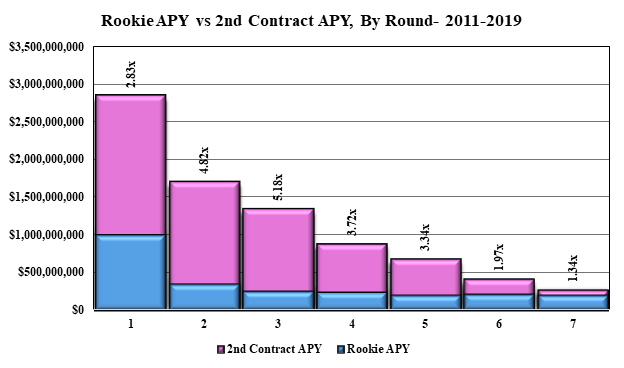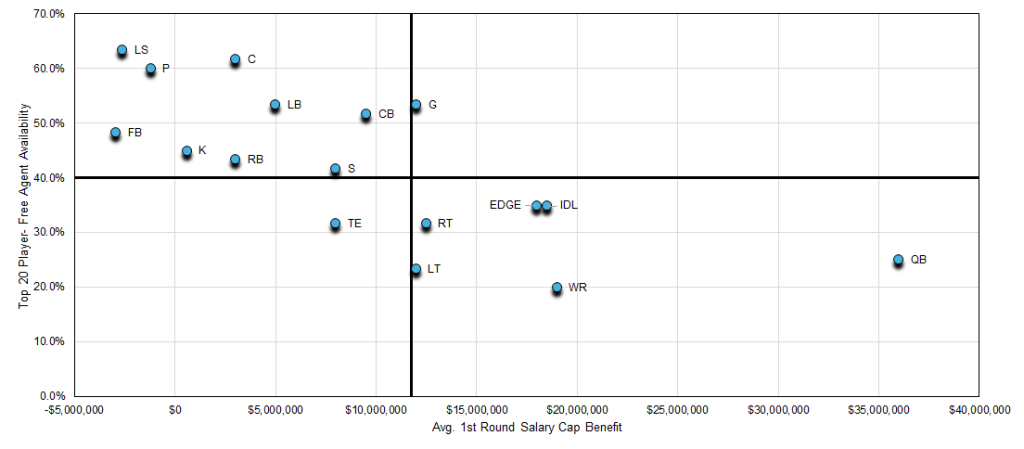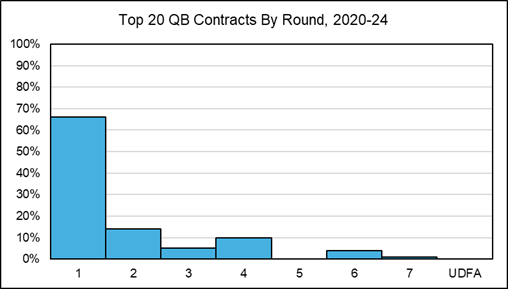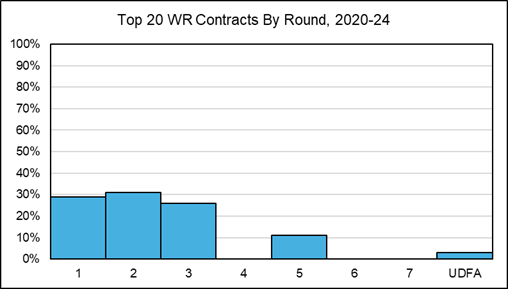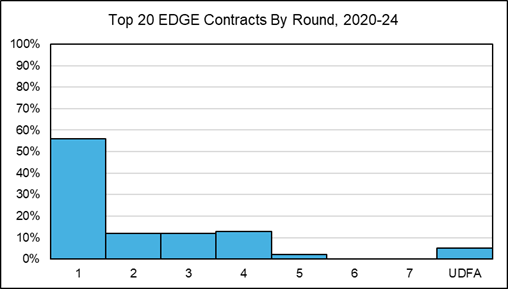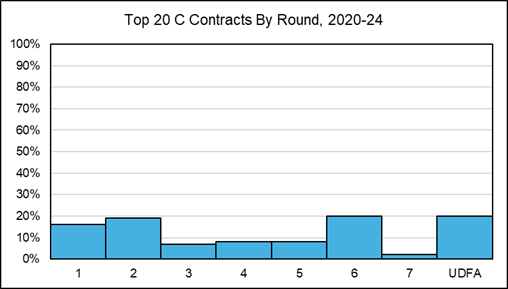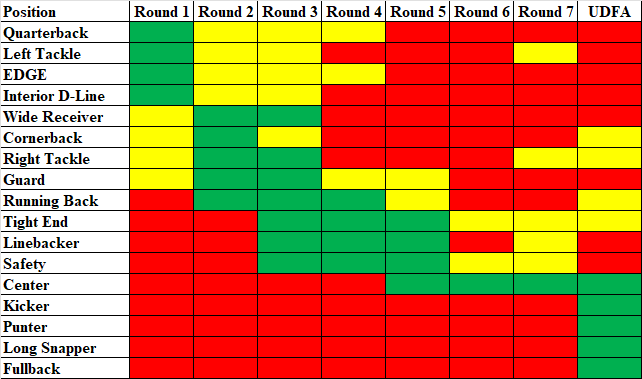With the second round of the 2024 draft in the books I wanted to go and look at the seven trades that were made during the draft. For each trade I am evaluating the trade using the Fitzgerald-Spielberger draft chart. The chart which Brad and I created is based on past results of NFL drafts. These values are not going to be indicative of typical trade markets in the NFL but they do provide you the expected returns on each trade when you wind up with the average outcome.
For each trade we calculate points for each draft pick. I am valuing a future pick as the last pick in that particular round, which is the worst possible scenario for a team receiving a future pick and best possible scenario for a team trading it away. The difference between these two is the implied cost of the trade. That cost can then be translated into a single draft pick.
The expected value added for a team is what that draft slot would project at if we translated the rookie performance into veteran contract value (i.e. a QB selected number 1 in the draft would expect to bring a team a value of $50.4M, essentially projecting as one of the top 5 players at the position). The value lost is what the picks the team traded away would be valued as. For the team trading up the value will be specific to the position they traded up for. For the team trading down it will be a blind trade since there is no guarantee on positional availability. The difference is how much was gained or lost by moving up rather than picking blind.
7. Chargers Select WR Ladd McConkey
Implied Cost: 68 points (Less than the last pick in the draft)
Potential Salary Lost: ($2,545,065)
| Selection | Points | Expected Value Added | Traded Picks | Points | Expected Value Lost |
| 34 | 1,213 | $11,101,435 | 37 | 1,170 | $7,813,575 |
| 137 | 507 | $3,383,678 | 110 | 618 | $4,126,473 |
| Total | 1,720 | $14,485,114 | 1,788 | $11,940,048 |
There was a trend in the 2nd round today of teams making some very fair trades using more modern rather than traditional valuation methods and this was one of those deals. The Chargers moved up a few spots to grab a premium position that on average would produce an $11.1 million per year receiver and the odds are in favor of wide receivers in this round so it probably should be higher than that. The move up was basically a mid draft pick swap with the Patriots getting 110 for 137.
While the salary here skews in the favor of the Chargers that does not make this a bad trade for New England as he was not a player they valued. They pick up some higher upside with pick 110 and a little better contract at 37.
6. Chiefs Select OT Kingsley Suamataia
Implied Cost: 92 points (Less than the last pick in the draft)
Potential Salary Lost: $366,685
| Selection | Points | Expected Value Added | Traded Picks | Points | Expected Value Lost |
| 63 | 900 | $6,264,518 | 64 | 892 | $5,959,250 |
| 211 | 288 | $1,922,197 | 173 | 388 | $2,594,150 |
| Total | 1,188 | $8,186,714 | 1,281 | $8,553,400 |
Is there a point to moving up one slot in the draft? Probably not, but it is human nature to fall in love with certain players and when the player is this close it is normal to want to ensure you get the player. If you are going to make that kind of trade this is the way to do it. So many teams would just throw in pick 173 and call it a day, but negotiating to get another late pick back is smart and limits the upside that is being sent to the other team. A very fair trade for the two teams involved.
5. Eagles Select CB Cooper DeJean
Implied Cost: 54 points (Less than the last pick in the draft)
Potential Salary Lost: $500,690
| Selection | Points | Expected Value Added | Traded Picks | Points | Expected Value Lost |
| 40 | 1,131 | $7,406,920 | 50 | 1,018 | $6,794,629 |
| 78 | 792 | $5,289,803 | 53 | 988 | $6,597,446 |
| 152 | 454 | $3,032,080 | 161 | 425 | $2,837,418 |
Quite frankly I am not sure if we will see a fairer deal than this when discussing a jump of more than a few draft slots. Philadelphia jumps 10 spots to get their targeted corner and basically swap 53 for 78 and 161 to jump to 152. A super fair trade that fits what both sides are looking for in a draft and even the values here work out perfectly even.
The one thing that I was seeing online in heavy praise of the trade was the fact that DeJean had a first round grade and therefore this is a steal. There is a reason players fall so using pre-draft grades is really not a reason for giving “bonus points” to a trade.
4. Falcons Select DT Ruke Orhorhoro
Implied Cost: 330 points (The 194th pick in the draft)
Potential Salary Lost: ($741,798)
| Selection | Points | Expected Value Added | Traded Picks | Points | Expected Value Lost |
| 35 | 1,198 | $10,944,549 | 43 | 1,094 | $7,305,017 |
| 186 | 352 | $2,348,960 | 79 | 786 | $5,246,694 |
| Total | 1,550 | $13,293,510 | 1,880 | $12,551,711 |
This is an example of a trade where the position you select can mitigate the premium you pay. In this case the Falcons lost 330 points to the Cardinals, which is worth the same as the 194th pick, but when we plug in the value of a defensive tackle instead of a blind position, the Falcons actually gain in the trade. That makes a solid deal for both sides. The Falcons did a good job of getting ahead of the defensive tackle run which may have leveraged them further in the trade market though it sounds as if the player they selected was not close to a unanimous choice at this point.
In any case this is a solid trade for the Falcons and for the Cardinals a good way to gain a high probability of starting pick by going from 186 to 79 and Arizona’s roster is so barren they need starters. A win-win for both teams here.
3. Saints Select CB Kool-Aid McKinstry
Implied Cost: 697 points (The 90th pick in the draft)
Potential Salary Lost: $4,796,583
| Selection | Points | Expected Value Added | Traded Picks | Points | Expected Value Lost |
| 41 | 1,118 | $7,324,941 | 45 | 1,071 | $7,151,172 |
| 168 | 403 | $2,693,395 | |||
| 190 | 341 | $2,276,957 | |||
| Total | 1,118 | $7,324,941 | 1,815 | $12,121,524 |
New Orleans gains very little by jumping four spots and just throws two picks to the Packers to do it. Compare this to what the Eagles or Chiefs did above. Those teams worked to find trade packages that worked by continuously going pick for pick and that keeps the upside of having all of those multiple picks in place for the team trading up. This is just the “let’s get it done” trade probably because panic set in when the Eagles moved up for DeJean. There is far too much variance in the draft to put all of your faith in a 2nd round corner. This is a really solid trade for Green Bay who gets a few chances to land a contributor later in the draft.
2. Rams Select DT Braden Fiske
Implied Cost: 1,191 points (The 35th pick in the draft)
Potential Salary Lost: $5,143,428
| Selection | Points | Expected Value Added | Traded Picks | Points | Expected Value Lost |
| 39 | 1,143 | $10,443,668 | 52 | 998 | $6,661,906 |
| 155 | 444 | $2,965,940 | |||
| 64 | 892 | $5,959,250 | |||
| Total | 1,143 | $10,443,668 | 2,334 | $15,587,096 |
This came across like a complete panic move. Just a few picks earlier we saw the Falcons move up 8 spots for a negligible cost by using a pick swap, but here we get a jump of 13 and the Rams not only include 155 from this year, but a blind 2nd round pick in 2025. I get the team wanted a defensive tackle and the run on defensive tackles probably spooked the Rams, but you just can not make this trade for the fourth interior defensive lineman taken in the 2nd round. You have to at least get something back from Carolina in the trade to offset the cost of next year’s second rounder. Fiske will need to be a top 20 defensive tackle to justify the trade up and maybe he will be that but that is a low probability outcome.
In terms of value this was the 2nd worst trade of the draft behind the Vikings trade in the first round for Dallas Turner. The only reason it is not the worst of the 2nd round is because these same Panthers, who got a great deal here, completely flubbed the entire process a few picks later.
1. Panthers Select RB Jonathon Brooks
Implied Cost: 871 points (The 66th pick in the draft)
Potential Salary Lost: $8,058,011
| Selection | Points | Expected Value Added | Traded Picks | Points | Expected Value Lost |
| 46 | 1,060 | $4,832,209 | 52 | 998 | $6,661,906 |
| 142 | 489 | $3,262,374 | |||
| 155 | 444 | $2,965,940 | |||
| Total | 1,060 | $4,832,209 | 1,930 | $12,890,220 |
The Panthers went from landing one of the best possible trades in the 2nd round to making one of the worst trades around ten minutes later. The team moves up six spots to select a running back coming off an ACL injury making this a double whammy. By using the high pick on a running back they actually have less value than a blind pick at 52 where they would select a position that is more productive in today’s NFL. They throw in picks 142 and 155 to get up there to boot, giving the Colts access to some players who have a chance to be very productive if they get lucky with one of the picks.
I get that the QB was bad last year and one of the cliches we fall back on is “he needs a running game” but that just isn’t true. What the Panthers need are players and they just gave two of them away for picking a player that they should not be picking in the first place and one who likely would have been there at 52. It is hard for a 2nd round trade to have this kind of disparity in projected player impact with an $8 million gap between the projected value for a RB selected at 46 and all of these other picks. Brooks has to be a top five player to justify the trade and even then it is iffy since there are so many other important positions to select.
